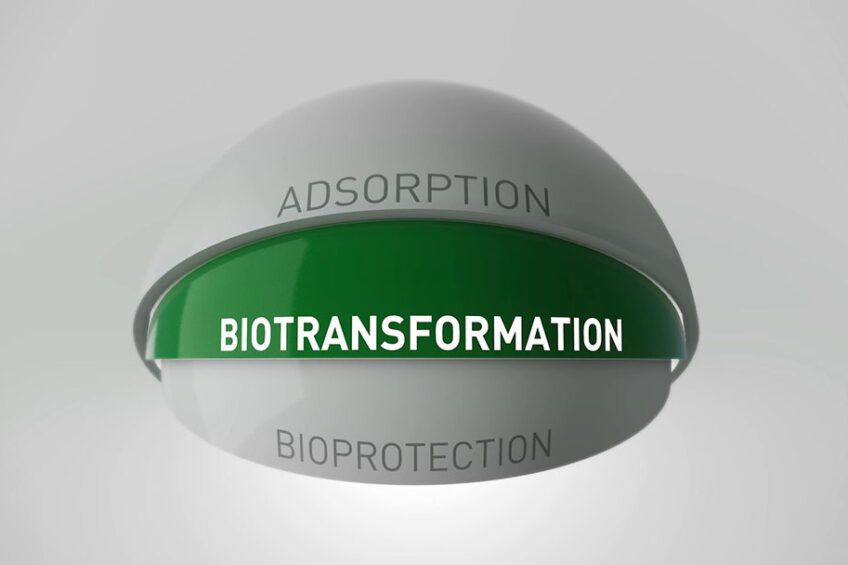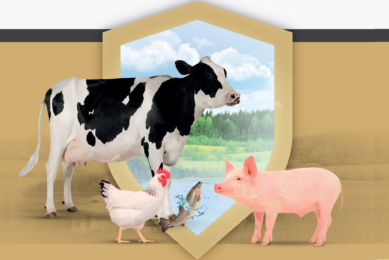Going beyond binders

While high quality binders are capable of neutralising aflatoxins, biotransformation is the state-of-the-art technology needed to address other mycotoxins and combat the global threat of mycotoxins successfully.
The hundreds of mycotoxins identified by researchers to date differ in their chemical and physical structures, and biochemical properties. Biochemical properties determine the toxicity of mycotoxins and the methods that can be used to detoxify them depend on the chemical and physical properties. With so much diversity, there is no single effective strategy that allows to mitigate the risk of all mycotoxins, or even the main agriculturally relevant ones.
Mycotoxin occurrence year to date
Results of the newest Biomin Mycotoxin Survey report show that in various regions of the world, different mycotoxins prevail, and –importantly– are often present at the same time (known as co-contamination). Since 2004, Biomin has collected and analysed feed material samples from throughout the globe in order to help their customers get a more reliable picture of mycotoxin occurrence. In total, 9,730 samples were analysed in the first half of 2019. Fumonisins (FUM) and deoxynivalenol (DON) remain the most prevalent mycotoxins worldwide (73% and 70%, respectively) among the six main well-known mycotoxins—the other four being aflatoxin (Afla), zearalenone (ZEN), ochratoxin A and T-2 toxin. These findings are consistent with previous years.

Europe and Africa
In Europe (1,918 samples), the risk of mycotoxin threat is severe. Particularly wheat and corn silage shows a high contamination with DON (64% and average 574 ppb; 71%, 534 ppb, respectively). In Southern Europe, prevalence of Afla increased compared to last year. Sub-Saharan Africa (n=112) shows high contamination with Afla (69%, average 18 ppb, median 4 ppb), FUM (88%) and DON (79%).
Americas
FUM and DON are highly prevalent in North and Central America, both regions are rated to be at an extreme risk of mycotoxin threat to livestock. In North America (1,062 samples), DON shows a high average and median concentration (1,397 and 583 ppb). Besides DON and FUM also ZEN is an issue (61%, average 452 ppb, median 153 ppb). In Central America (n=360), FUM is most prevalent with 83% (average 2297 ppb, median 799 ppb), followed by DON. ZEN is abundant with high average concentration (397 ppb; median 108 ppb). South America (4,092 samples) shows a high abundance of FUM (74%, average 2195 ppb, median 1365 ppb) and DON (64%, average 862 ppb, median 630 ppb).
Asia Pacific
Extreme risk can be further observed in most parts of Asia. In South Asia (n=112), the main threat is Afla (91% abundance, average 19 ppb, median 7 ppb). South East Asia (n=132) is threatened by Afla (60%, average 47 ppb, median 16 ppb) and FUM (80%, averages 1631 ppb, median 560 ppb). Interestingly, in China/Taiwan (n=1380) the risk is rather due to FUM (93% prevalence, average 1983 ppb, median 684 ppb), DON (91%) and ZEN (83%), but also Afla (30%). At moderate risk is Oceania.
What can be bound
The most well-known strategy for mycotoxin deactivation is adsorption or, colloquially speaking, binding. Toxin binders are nutritionally inert compounds that, when added to animal feed, adsorb toxins such as mycotoxins in the gastrointestinal tract of animals, thus reducing the amount of toxins that can be absorbed by the animal.
Adsorption efficacy
The adsorption efficacy of commonly used binders (such as mineral clays) is limited to a few mycotoxins, such as aflatoxins, ergot alkaloids, and endotoxins. However, binders have been shown to have limited efficiency in preventing toxic effects of Fusarium mycotoxins, such as trichothecenes (e.g. DON or T-2 toxin), ZEN or fumonisins. These findings are in line with results from the studies performed according to a standard protocol for mycotoxin adsorption using binder products sold in different markets around the world.
Figure 1 – Adsorption efficacy of DON by various substances.Deoxynivalenol is not adsorbed effectively by any of thesubstances tested (conditions: 0,2% binder, 1000 ppb DON).
Most of the clay minerals at inclusion rate of 0.2% (corresponds to 2 kg of binder per 1 ton of feed) bound more than 85% of 200 ppb Afla at pH 3.0 as well as at pH 6.5 in the standard method. Only a few of the tested clay minerals bind more than 90% of 4000 ppb AfB1 at an inclusion of 0.02% (200 g of binder per 1 ton) at pH 5 (official EURL method for testing bentonite binding efficiency). However, these resulted in less than 25% adsorption rate for 1000 ppb DON (Figure 1). Organic materials such as yeast products bound less than 20% of Afla and DON. Therefore, alternative approaches for efficient detoxification of mycotoxins are required.
Innovation in detoxification
Biotransformation, a strategy that is gaining wider acceptance nowadays, uses microorganisms or purified enzymes to catabolise the entire mycotoxin or transform or split it into non-toxic compounds. Interestingly, the use of microorganisms selected from soil or animal microbiomes to counteract mycotoxins was documented by Ciegler et al. in 1966, prior to the discovery of mineral binders.
Two components of the Mycofix product
Biomin is the first and only to commercialise feed additives that biotransform mycotoxins successfully with two components of the Mycofix product line: FUMzyme biotransforms fumonisins and Biomin BBSH 797 detoxifies trichothecenes. These patented, specific enzymes and biological components convert mycotoxins into non-toxic, environmentally safe metabolites in the digestive tract of animals. Three benefits of biotransformation versus conventional binders are:
- Biotransformation is irreversible, regardless of changing pH levels.
- Enzymes used for biotransformation are substrate-specific.
- They are specific solutions designed to counteract the frequently occurring fumonisins and trichothecenes selectively.

Including a biotransformation strategy
The European Union regulations (EU) 1115/2014, 2017/913, 2018/1568 and (EU) 1016/2013 and 2017/930 followed a series of procedural steps affirming the safety and effectiveness of FUMzyme and Biomin BBSH 797 as substances for the reduction of the contamination of feed by mycotoxins (fumonisins and trichothecenes, respectively) for pigs and all avian species. Efficacy of the components were demonstrated both in vitro as well as in vivo (Figure 2).
In light of the predominance of fumonisins and trichothecenes and the threat from co-contamination, producers should go beyond binders by including a biotransformation strategy in their mycotoxin risk management program. This coupled with regular mycotoxin testing, will help to ensure higher feed quality, better performance and genuine return on investment.
Authors: Renata Olejniczak, Mycotoxin Risk Management Product Manager and Anneliese Mueller, Product Management Associate, Biomin
Join 13,000+ subscribers
Subscribe to our newsletter to stay updated about all the need-to-know content in the dairy sector, two times a week.











